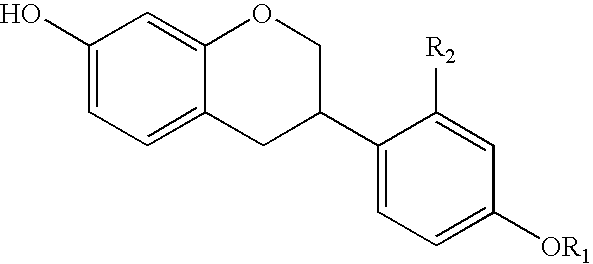Manufacturing process of isoflavan or isoflavene derivatives
a technology of isoflavan and isoflavene, which is applied in the field of synthesizing isoflavan and isoflavene derivatives, can solve the problems of preventing the method of hydrogenation from being suitable, the above-mentioned methods are not suitable for synthesis of glabridin, and the synthetic methods of the compounds are not fully developed, so as to achieve more effective and convenient production
- Summary
- Abstract
- Description
- Claims
- Application Information
AI Technical Summary
Benefits of technology
Problems solved by technology
Method used
Image
Examples
preparation example 1
Preparation of 5-benzoyloxy-2,2-dimethyl-6-formyl-2H-1-benszopyran
[0039] 2,2-dimethyl-6-formyl-5-hydroxy-2H-1-benzopyran (2.04 gr, 10.0 mmol) synthesized according to the reference (Clarke, D., Crombie, L., Whiting, D. A., J.Chem., Chem. Comm., 1973, 580p-582p), benzoyl chloride (1.48 gr, 10.5 mmol) and K2CO3 (1.38 gr, 10.0 mmol) were dissolved in acetone (30 mL) and stirred for 3 hours. The solution was filtered to remove salt, the filterate was concentrated under reduced pressure. The residue was dissolved in ethyl acetate and washed with brine, then dried over anhydrous MgSO4 and concentrated under reduced pressure to give 5-benzoyloxy-2,2-dimethyl-6-Formyl-2H-1-benzopyran (3.08 gr, 10.0 mmol).
[0040]1H-NMR(CDCl3): 9.92(s, 1H), 8.25(d, 2H), 7.71(d, 2H), 7.70(t, 1H), 7.55(t, 2H), 6.83(d, 1H), 6.38(d, 1H), 5.69(d, 1H), 1.49(s, 6H)
preparation example 2
Preparation of 2,2-dimethyl-6-Formyl-5-pivaroyloxy-2H-1-benzopyran
[0041] 5-benzoyloxy-2,2-dimethyl-6-Formyl-2H-1-benzopyran (2.04 gr, 10.0 mmol) and pivaloyl chloride (1.3gr, 10.5 mmol) were dissolved in acetone (30 mL). 2,2-dimethyl-6-Formyl-5-pivaroyloxy-2H-1-benzopyran was obtained (2.88 gr, 10.0 mmol) as described in the Preparation example 1.
[0042]1H-NMR(CDCl3): 9.85(s, 1H), 7.65(d, 1H), 6.77(d, 1H), 6.29(d, 1H), 5.71(d, 1H), 1.47(s, 6H), 1.44(s, 9H)
preparation example 3
Preparation of methyl 2′,4′-dibenzyloxyphenylacetate
[0043] 2′,4′-dibenzyloxyacetophenone (3.32 gr, 10.0 mmol) was dissolved in methanol (50 mL), then hyperchloric acid (5 mL) was added. Ti(NO3)3·3H2O (5.55 g, 12.5 mmol)was added slowly to the solution over 30 minutes and the solution was stirred for 5 hours at room temperature. The solution was filtered and concentrated. The residue was dissolved in ethyl acetate (50 mL) and washed with brine twice (2×50 mL), then dried over anhydrous MgSO4 and concentrated under reduced pressure to give methyl 2,4-dibenzyloxyphenylacetate (3.15 g, 8.7 mmol).
[0044]1H-NMR(CDCl3): 7.3˜7.5(b, 10H), 7.11(d, 1H), 6.60(d, 1H), 6.54(dd, 1H), 5.03(s, 4H), 3.63(s, 3H), 3.61(s, 2H)
PUM
| Property | Measurement | Unit |
|---|---|---|
| reaction temperature | aaaaa | aaaaa |
| pressure | aaaaa | aaaaa |
| temperature | aaaaa | aaaaa |
Abstract
Description
Claims
Application Information
 Login to View More
Login to View More - R&D
- Intellectual Property
- Life Sciences
- Materials
- Tech Scout
- Unparalleled Data Quality
- Higher Quality Content
- 60% Fewer Hallucinations
Browse by: Latest US Patents, China's latest patents, Technical Efficacy Thesaurus, Application Domain, Technology Topic, Popular Technical Reports.
© 2025 PatSnap. All rights reserved.Legal|Privacy policy|Modern Slavery Act Transparency Statement|Sitemap|About US| Contact US: help@patsnap.com



